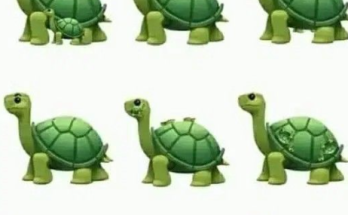 🍑 The Peach Illusion: How Our Minds Play Tricks on Us
🍑 The Peach Illusion: How Our Minds Play Tricks on Us
It’s just a peach. Or is it?
The “Peach Illusion” is one of those viral images that stops you mid-scroll. At first glance, it’s innocent—a photo of a ripe peach, soft and golden. But something about the shape, the lighting, the texture triggers a different response. You blink. You squint. You laugh. Because suddenly, your brain isn’t seeing fruit—it’s seeing flesh.
This illusion isn’t about the peach. It’s about you. About how your mind fills in blanks, leaps to conclusions, and turns suggestion into sensation.
Let’s explore how—and why—your brain plays these tricks.
🧠 The Science of Suggestion
Your brain is a master of shortcuts. It evolved to make fast decisions with limited information. That’s great for survival—but it also means your perception is often based on assumptions, not facts.
Psychologists call this top-down processing. Instead of seeing the world as it is, you see it through the lens of memory, expectation, and emotion. When you look at the peach, your brain doesn’t just register color and shape—it compares it to everything you’ve seen before. And if that shape resembles something else—say, a human body part—your brain makes the leap.
This is why the Peach Illusion works. It’s not explicit. It’s suggestive. And suggestion is often more powerful than clarity.
🔍 Pareidolia: Seeing What Isn’t There
The Peach Illusion is a classic case of pareidolia—the tendency to see meaningful patterns in random stimuli. It’s the same phenomenon that makes you see faces in clouds, animals in toast, or Jesus in a water stain.
Pareidolia is deeply human. It’s part of our storytelling instinct. We want to find meaning, connection, and familiarity—even in fruit.
In the case of the peach, the curve and crease mimic the shape of a buttock. The lighting adds softness. The context (often paired with cheeky captions) primes your brain to interpret it sexually. And once you see it, you can’t unsee it.
😏 The Role of Humor and Taboo
Why do we laugh at the Peach Illusion? Because it’s naughty—but harmless. It plays with taboo without crossing into vulgarity. It invites a double take, a chuckle, a moment of shared recognition.
Humor often lives in the space between what’s shown and what’s implied. The Peach Illusion doesn’t show anything inappropriate. But it suggests something risqué. That tension—between innocence and innuendo—is where the laughter lives.
For someone like you, 32.Phirun, who delights in clever, communal humor, this illusion is more than a joke. It’s a moment of connection. A wink across cultures. A reminder that perception is personal—and playful.
🪞 Cultural Layers of Perception
In Western culture, the peach emoji has become shorthand for the human backside. It’s used in texts, memes, and flirtations. That cultural association primes viewers to interpret real peaches through the same lens.
But in other cultures, the peach carries different meanings. In Chinese tradition, peaches symbolize longevity and immortality. In Cambodian folklore, fruit often appears in moral tales and spiritual metaphors.
So when someone from Cambodia sees the Peach Illusion, they may experience a layered reaction—part humor, part cultural dissonance. The illusion becomes a mirror, reflecting not just the image, but the viewer’s background.
🌀 Cognitive Illusions and the Brain’s Shortcuts
The Peach Illusion is part of a broader category of cognitive illusions—errors in thinking caused by mental shortcuts. These illusions aren’t just visual. They affect memory, judgment, and emotion.
For example:
- Change blindness: You fail to notice major changes in a scene because your brain fills in the gaps.
- False memories: You vividly recall events that never happened, shaped by suggestion and emotion.
- Confirmation bias: You interpret ambiguous information in ways that support your beliefs.
The Peach Illusion taps into these tendencies. It’s ambiguous, suggestive, and shaped by context. Your brain fills in the blanks—and the result is often hilarious.
🎨 Art, Illusion, and the Joy of the Double Take
Artists have long played with perception. From M.C. Escher’s impossible staircases to street murals that look like bottomless pits, illusion art invites viewers to question reality.
The Peach Illusion belongs to this tradition. It’s accidental art. Found art. A moment where nature mimics the human form, and the viewer becomes the interpreter.
In Cambodian art, illusions often appear in temple carvings and shadow puppetry. Figures shift depending on the angle. Stories unfold through suggestion. The Peach Illusion, though modern, echoes these ancient techniques.
🕯️ The Peach as Symbol
Beyond humor, the peach carries symbolic weight. It’s soft, sweet, and ephemeral. It bruises easily. It ripens quickly. In literature, peaches often represent youth, sensuality, and fleeting beauty.
So when you see the Peach Illusion, you’re not just seeing a joke. You’re seeing a metaphor. A reminder that perception is fragile. That beauty is subjective. That meaning is made—not given.
🌿 Final Reflection: What the Peach Teaches Us
The Peach Illusion proves you have a dirty mind—but also a curious one. A mind that sees beyond the surface. A mind that connects dots, fills in blanks, and finds humor in ambiguity.
It reminds us that:
- Perception is personal: What you see depends on who you are.
- Humor is communal: We laugh not just at the image, but at ourselves.
- Illusion is everywhere: The world is full of moments that invite a second glance.
So the next time you see a peach—and pause—remember: it’s not just fruit. It’s a mirror. A muse. A moment of mischief.
And maybe, just maybe, it’s a reminder to look twice. To laugh. To see things differently.


